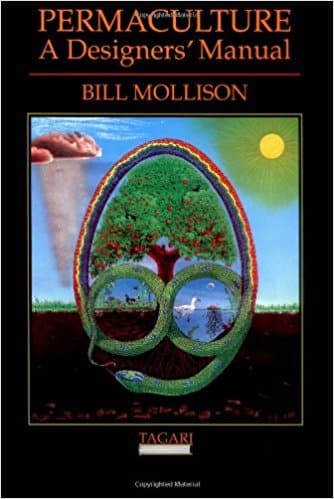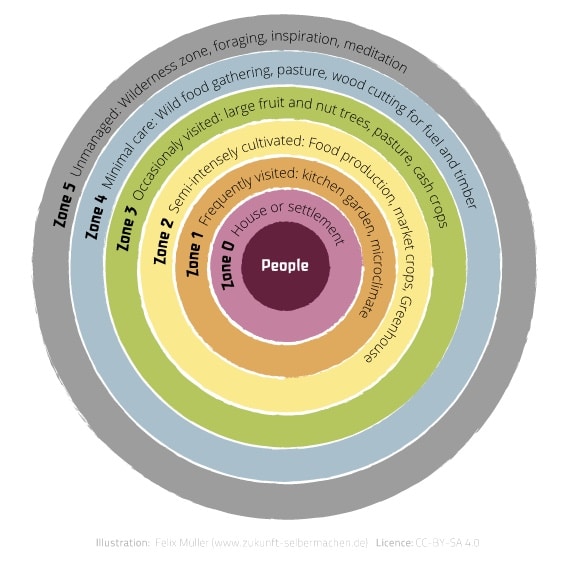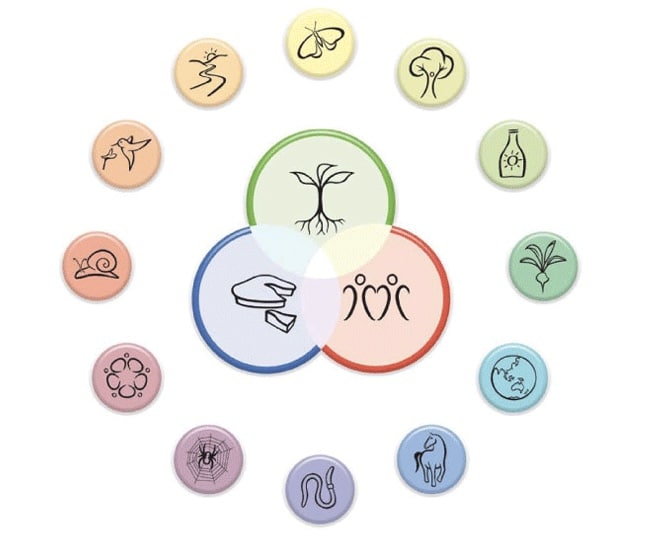Permaculture is an “ethical design science used as an Earth repair vehicle” (Geoff Lawton, Permaculture Voices 1, 2014: “The Permaculture Designer’s Manual in One Hour“)
 Permaculture is a design science introduced in 1978 by Bill Mollison and David Holmgren through their publication of “Permaculture: A Designer’s Manual“. The word “permaculture” comes from the combination of “permanent” + “agriculture”. Since food is vital for culture, permaculture is also “permanent” + “culture”.
Permaculture is a design science introduced in 1978 by Bill Mollison and David Holmgren through their publication of “Permaculture: A Designer’s Manual“. The word “permaculture” comes from the combination of “permanent” + “agriculture”. Since food is vital for culture, permaculture is also “permanent” + “culture”.
If you are someone who tries to buy the most ethical and healthy food you can, you are familiar with non-GMO, organic food. You are also probably familiar with the fact that industrially-produced meat is bad for the environment. However, permaculture food, including meat, is beyond organic — it actually heals and restores our environment. Designing and encouraging permaculture systems, especially while including rotational grazing, are an important long-term solution for many of our current problems: increasing top soil (and thus increasing the ability to sequester carbon; see this article on a new technique for more accurately measuring carbon in soil samples), creating food, restoring trees, increasing the productivity of land, preventing erosion, feeding people, creating surplus to share with others, deepening resilience, and more.
Permaculture is a way of thinking, a way of designing human

Felix Müller, Creative Commons Attribution-Share Alike 4.0 International
habitats that provide the Food, Fuel, Fiber, Fodder, Fertilizer, Farmerceutics (Pharmaceutics), and Fun (the 7 “Fs”). Permaculture systems are designed synergistically with the goal of one element serving multiple functions. For example, a chicken prepares the garden for planting by scratching, eats weed seeds, eats bugs, deposits nitrogen, and provides eggs and meat. If they are turned loose on food scraps, they are also composters. If all of this happens in a green house, their body heat and exhalation (of CO2) help the plants.

Diagram by Graham Burnett,
(Reusing this file)
Released under the GNU Free Documentation License.
Permaculture is often associated with a few key concepts: The 12 Permaculture Principles (illustrated in the top image by David Holmgren), keyline design, the Five Permaculture Zones (as illustrated above), and the design of Food Forests (or Forest Gardens) that are collections of multipurpose, perennial (see wild rice in WI as an example of a perennial that used to be a mainstay in that state), diverse plants occupying multiple vertical layers (see graphic above) — and thus taking more advantage of solar energy than one-height monocultures — that are resistant to disease and varying climate conditions (because of their diversity) and produce the 7 Fs as already discussed. Our tiny, backyard permaculture project is an example of applying these principles.
It is sometimes assumed that growing annual grains is antithetical to permaculture practice. However, this is not the case. It is perfectly sensible to grow annual grains alongside food forests as is done at Salamander Springs Farm in Kentucky using methods inspired by Masanobu Fukuoka’s techniques for growing rice and barley, techniques that involved permanent cover crops and broadcasting seeds.

Permaculture was co-founded by Bill Mollison and David Holmgren in 1978 with the publication of the first edition of the “Permaculture: A Designers Manual“. Current editions are used today as the foundation for a standardized 72-hour Permaculture Design Course (PDC), taught throughout the world (you can also listen to an audio version of PDC taught by Bill Millison). The first 4 chapters are the core of the course and the manual according to Geoff Lawton (Geoff Lawton, Permaculture Voices 1, 2014: “The Permaculture Designer’s Manual in One Hour“) with subsequent chapters providing a focus for this core. The first four chapters cover the Introduction (Chapter 1), Concepts and Themes in Design (Chapter 2), Methods of Design (Chapter 3), and Pattern Understanding (Chapter 4). Subsequent chapters cover Climate, Trees (with emphasis on the importance of condensation), Water, Soil (including understanding the interaction of water and the carbon cycle to create soil), and earthworks (Chapters 5-9). Chapters 10-13 cover different climates from humid to dry to aquaculture and the final chapter (14) focuses on what we might call “social permaculture” — applying permaculture design to communities of people.

Permaculture Experts
Mark Shepard (WI, his book), the Bullock Brothers (WA), Paul Wheaton who also founded and maintains an excellent forum (MT), Willie Smits (Borneo), Geoff Lawton (Australia; also see, Greening the Desert in Jordan), and Ben Falk (VT, his book) are examples of practitioners (see more here). Like any group of people trying to do something, there are flawed aspects of permaculture (see this article for a social critique). There is also discussion of open source permaculture: using open source sharing of knowledge approaches to reducing trial and error on practical permaculture projects. The excellent film, Inhabit: A Permaculture Perspective, covers many of the concepts central to permaculture through the words of several permaculture practitioners.

Pingback: The Mother Ship of Permaculture Forums: Permies.com | One Planet Thriving
Pingback: From Grass to Food? Backyard Permaculture Project | One Planet Thriving
Pingback: Greening the Desert – Geoff Lawton | One Planet Thriving
Pingback: Thriving on One Planet: The Big Picture | One Planet Thriving
Pingback: Wild Rice in Wisconsin | One Planet Thriving
Pingback: Financial Resilience | One Planet Thriving
Pingback: The Dysfunctional Status Quo | One Planet Thriving
Pingback: Reflections on my first summer at Troy Gardens Cohousing | One Planet Thriving
Pingback: Top 5 lessons learned living in a village: A psychologist’s view | One Planet Thriving
Pingback: Food is Central for Civilization | One Planet Thriving
Pingback: The Four Principles of Sustainable Life | One Planet Thriving
Pingback: Greening the Desert in Jordan – Geoff Lawton | One Planet Thriving
Pingback: The Big 9 Solutions for Restoring Our Future Now | One Planet Thriving
Pingback: Chapter 14: Strategies for an Alternative Nation, Permaculture: A Designer’s Manual — Notes | One Planet Thriving
Pingback: Social Technology Overview | One Planet Thriving
Pingback: Intimacy Strategies for Thriving | One Planet Thriving